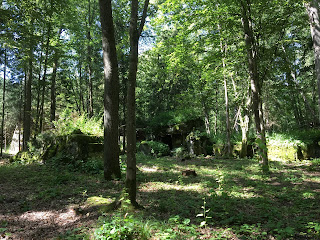Off to Warsaw We Go
We check out of our fortress hotel after an eclectic breakfast (thankfully no tripe but some other interesting bits and pieces!) The dining room is rustic and charming. We collect our picnic lunch bag as we leave. We’ve not seen apples so huge and, OMG, we will not go hungry!
We drive a short distance, past flat green fields and tidy hay bales, to the Wolf’s Lair in the Gierloz forest. The complex was constructed in 1941 as a top secret, high security site for The Fuhrer and his planned attack on the USSR. His infamous bunker is here amongst the trees and it is at this very site where the unsuccessful attempt on his life was made. We are standing right there. What a damn shame it failed.
Our very earnest guide is a Professor of History and he gives us a full-on history lecture as we stand in front of a large map showing how things used to look. We may have sweated our way around many sites on this trip, but here we are standing in shady woods with a cool breeze blowing. It’s actually jolly chilly. As we shiver, our guide enthusiastically tells us about the war - and just about every other major event in human history! We want to see the bunkers in the woods, not see maps of countries that we know no longer exist or listen to details about wars we wished never did. At last he is ready to show us what we came for, and off we go.
There are sculptures of wolves at the entrance to the complex and we walk around a cluster of huge bunkers; dilapidated, covered in growth and rather eerie. We can see why they chose this spot - even seeing the bunkers with our own eyes, and standing right near them, it’s sometimes not easy to pick them out as actual buildings amongst the trees. What a major operation it must have been. Hitler apparently spent 800 days here between 1941 and 1944.
There was certainly little chance of being found by the enemy in here. I pity those whose duty it was to spend time here in any capacity, from staff to signatories, as well as Claus von Stauffenberg, the staff officer who carried the briefcase that carried the bomb that was supposed to kill the Wolf. Alas, due to changes of both meeting location and time, things didn’t go according to plan and four others were killed - but not the intended.
We traipse around this bunch of ruins with a difference, while our guide, who barely takes a breath as he imparts all sorts of information, keeps throwing down cat biscuits to hungry cats who simply can’t be hungry coz he keeps feeding them so many biscuits!
We peek inside a few bunkers, gawp at another massive concrete bunker, envisage life her during the war - this place is definitely not your usual tourist attraction. I’m pleased we spend time here in this oddball forest.
We move on to the church at Swieta Lipka; it may be an ABC (another bloody church) but, like them all, it too is staggering to see. The entrance gates are gorgeous in patina green, the frescoes are lovely and the organ looks impressive - but we ain’t seen nothing yet.
We eat our picnic lunch on a bench near the church and then go back inside for the organ recital. Not only is the blue and gold organ very ornate and beautiful, it has angels playing horns that move with the music. The first piece is the Triumphal March from Aida - this is also the music for my old school song. Bravo.
We continue on to Warsaw, arriving around 8pm. After checking into the rather chic Polonia Palace Hotel, the oldest in the city, we enjoy a meal in the restaurant. The Palace of Culture and Science is across the road and it looks magnificent lit up purple at night. There had been talk of demolishing it at one point as it was a reminder of communist days - but there wasn’t enough money to do it and so it still stands today. Good job too. Time for sleep.
OBSERVATION OF THE DAY: The roads are awesome. As a major transit country with many trucks, Poland was once known for its terrible, small and inadequate roads. There were plenty of highwaymen and robberies and the roads were not a safe place.
In 2004, when Poland joined the EU, a road-building programme, funded by the EU, enabled 100kms of new roads to be built. Now travel is much easier and safer - in fact, Poland is one of the safest countries in Europe, with a very low crime rate.
There are many roundabouts and safe driving practices in operation. Makes being on the road so much safer and more pleasurable.












Comments
Post a Comment